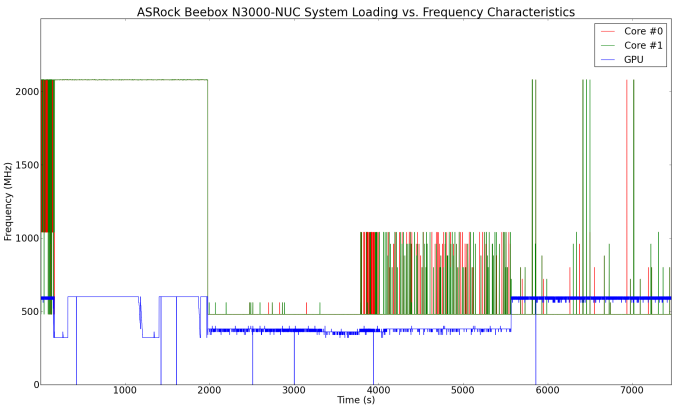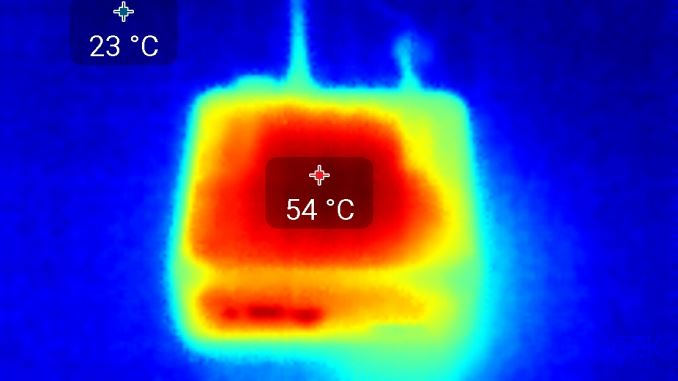ASRock Beebox Review: A Fanless Braswell UCFF PC
by Ganesh T S on July 14, 2015 8:00 AM ESTPower Consumption and Thermal Performance
The power consumption at the wall was measured with a 1080p display being driven through the HDMI port. In the graphs below, we compare the idle and load power of the ASRock Beebox N3000-NUC with other low power PCs evaluated before. For load power consumption, we ran Furmark 1.12.0 and Prime95 v27.9 together. In our initial run, the idle power was quite hight (more than 7 W). However, the installation of the Intel iRMT driver (Ready Mode Technology) was necessary to make the system behave well with the default BIOS settings. We repeated our tests after installing iRMT and recorded the numbers below.


The load power consumption is impressive, but it must be remembered that the SoC has only two cores and a TDP of 4W. The idle power consumption is reasonable, once the replaceable RAM and internal storage are considered.
The various clocks in the system as well as the temperatures within the unit are presented below. We start with the system at idle, followed by 30 minutes of pure CPU loading. This is followed by another 30 minutes of both CPU and GPU being loaded simultaneously. After this, the CPU load was removed, allowing the GPU to be loaded alone for another 30 minutes.
The Celeron N3000 manages to stay at the maximum turbo frequency of 2.08 GHz throughout the pure CPU stress segment. As soon as the GPU starts getting stressed alongside, the CPU cores drop down to around 500 MHz and the GPU starts clocking between 360 MHz and 400 MHz. Removing the CPU stress aspect allows the core to ramp up to 1.04 GHz as necessary to keep Furmark going along smoothly. It can be said that all these frequencies are managed to ensure that the TDP limits are obeyed. Sustained operation at the maximum turbo frequency for pure CPU loading indicates that the system's thermal design doesn't hobble the performance of the unit in any way.
Looking at the internal temperature during the loading process, we find that the thermal solution is able to keep the SoC well below the maximum junction temperature of 90 C. Even under heavy GPU loading (which seems to heat up the SoC faster than pure CPU loading), the temperature stabilizes around 84 C.
Another important aspect to keep note of while evaluating fanless PCs is the chassis temperature. Using Seek Thermal's thermal imager, we observed the chassis temperature after the CPU package temperature reached the steady state value in the above graph.
Even under extreme stress, the chassis temperature didn't cross 60 C. As FanlessTech notes, the thermal solution is very similar to that of the Zotac ZBOX C-series - a thermal pad on a small heat sink. However, this crude solution seems to be good enough for the Celeron N3000 - chassis temperatures remain in the safe territory, there is no thermal throttling and the SoC temperature remains well below TJmax.


















45 Comments
View All Comments
amakula77 - Tuesday, July 14, 2015 - link
This review is good but I think it needs an extra section to test this out as a low end gaming machine , with Bluetooth controller, this thing I'm sure could play older emulators and GOG and older steam games.amakula77 - Tuesday, July 14, 2015 - link
I did not see the Dolphin emulator test this is good by more gaming tests are needed to determine if this will be a suitable low end gaming machinenathanddrews - Tuesday, July 14, 2015 - link
Yeah, I'm thinking there is a missing graphic - normally they publish Dota 2 numbers or something. From Performance Metrics - I "GPU performance shows a similar trend to the CPU performance. The difference when compared to Bay Trail is considerable." But all I see is 3D Mark, where it is marginally faster than the LIVAX. Then on Performance Metrixs - II, it is marginally slower than LIVAX for Dolphin. I guess I'm not seeing anything in the way of GPU improvements from these data points. Did I miss something or is something missing?blakehaas - Tuesday, July 14, 2015 - link
I like the power usage, but the available ports are lacking. The CI320 has esata and a plethora of usb3.0.barleyguy - Tuesday, July 14, 2015 - link
eSata especially is a big advantage. (All of my media is stored a 4 TB eSata hard drive.)Kracer - Wednesday, July 29, 2015 - link
Is eSata that common?A NAS seems a much more universal solution.
Pissedoffyouth - Tuesday, July 14, 2015 - link
I'd like to see an i5 5775c in a box like this especially with the quiet laptop style blowers a lot of newer PC's have.barleyguy - Tuesday, July 14, 2015 - link
Zotac has some pretty powerful boxes similar to this. The EN860 is an i5 4210u with NVidia GTX 860M graphics. They will soon have an EN960 with 970M graphics. The EN860 has a silent cooler (completely silent at idle, and about 35 dB when gaming).They are a lot more expensive though. The EN860 is $500 barebones, and the EN960 will be coming in around $700 barebones.
owarchild - Tuesday, July 14, 2015 - link
@Ganesh T S, can you try this alpha version of OpenELEC: http://forum.kodi.tv/showthread.php?tid=231955&... Is should work on the Beebox as it has been used in a ASRock N3150 board.savagemike - Tuesday, July 14, 2015 - link
I don't understand your pricing comment that 128GB is a nice premium over 32GB for only $20. This also entails the loss of an operating system which costs around $100+ if that is the OS you want.In the same vain I don't understand the pricing of your system. How did you get 4GB/128GB and Windows 8.1 Pro 64 for $220?